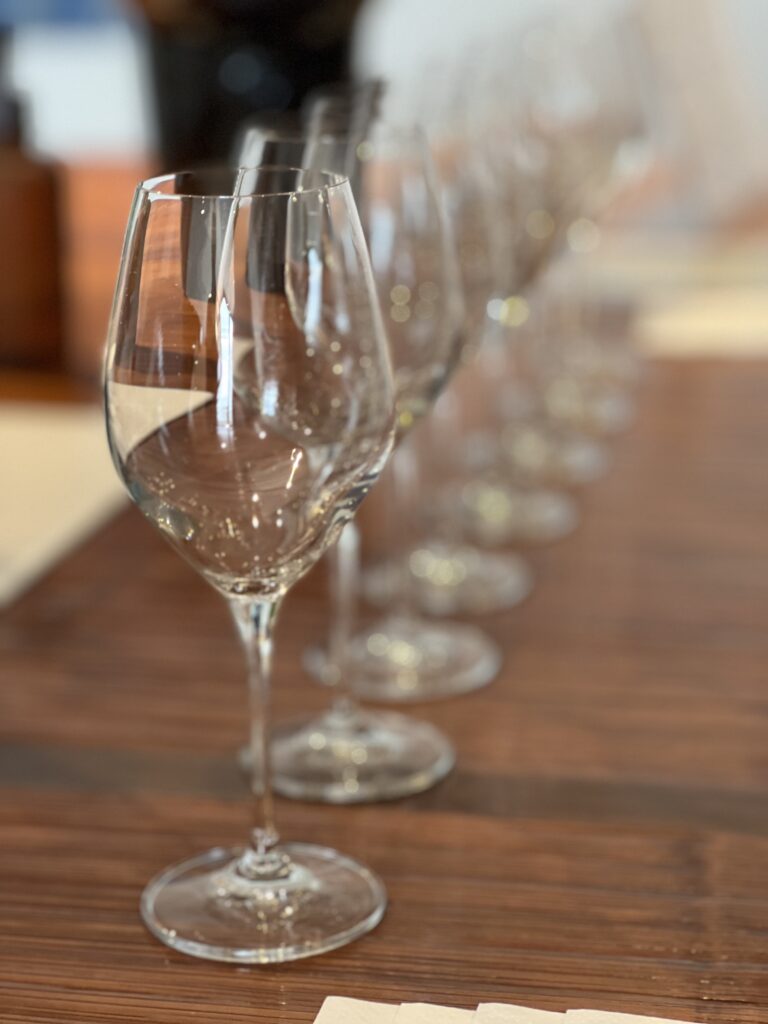
The 4 Essential Steps to Tasting Wine:
Wine tasting is all about enjoying the experience, so relax and savor every moment! Here’s a simple guide to help you make the most of your wine tasting:
1. Swirl
Hold your glass by the stem (this keeps it clean and prevents the wine from warming). Gently spin the glass in a circle to allow the wine to mix with the air, releasing its aromas. Swirling helps oxygenate the wine, allowing it to open up and reveal its full bouquet.
Next, tilt the glass at a slight angle and hold it up to a light or against a white surface. This lets you observe the color and clarity of the wine, as well as the legs—the droplets that form on the side of the glass. The appearance can provide clues about the wine’s alcohol level, sugar content, and even the grape variety. With time, you’ll be able to tell more about a wine just by looking at its legs!
2. Smell
To properly smell your wine, place your nose into the glass and take a deep breath. This is known as the “nose” of the wine, and it’s where you’ll discover a range of aromas. Wines typically display three layers of scent:
- Primary aromas come from the grapes and reflect the climate and terroir where they were grown. These include fruity and floral notes.
- Secondary aromas are produced during fermentation and the winemaking process. You may detect yeast, bread, or even buttery scents depending on the wine’s production method.
- Tertiary aromas evolve as the wine ages. These can range from earthy, nutty, or even leathery notes, adding complexity to the wine.
Be sure to take your time here—your sense of smell is key to understanding the wine’s full character.
3. Sip
Now it’s time to take your first sip! Take a swish and let the wine gently coat your mouth, allowing it to touch all parts of your palate. Notice the balance of sweetness, acidity, tannins, and alcohol. Pay attention to the texture (Is it smooth, silky, or rough?) and the flavors (Do they match the aromas you smelled, or are there new surprises?).
After taking your sip, you can either swallow or spit the wine (especially in a tasting setting). Focus on the finish—the lingering aftertaste that remains on your palate. A high-quality wine often has a long, pleasant finish that lasts a few seconds. Reflect on the mouthfeel (light, medium, or full-bodied) and how all the components come together.
4. Savor
The best part! Now that you’ve tasted the wine, take a moment to savor it. Enjoy the full experience—its texture, flavors, aromas, and finish. Discuss your impressions with others, or simply reflect on what stood out to you. Sharing your thoughts can deepen your understanding of the wine and improve your tasting skills over time.
Tip: Keep a wine tasting journal! Writing down your thoughts and impressions will help you learn more about the wines you like and what to look for in the future.
By following these four steps—Swirl, Smell, Sip, and Savor—you can develop a deeper appreciation for wine and make each tasting an enjoyable and educational experience. Enjoy the journey!